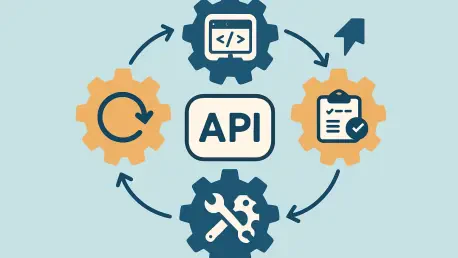In an era where digital transformation dictates the pace of business success, Application Programming Interfaces (APIs) have emerged as the linchpin of modern IT operations, enabling seamless integration across a myriad of systems and applications. As organizations grapple with increasingly complex hybrid environments that blend on-premise infrastructure with multi-cloud platforms, the ability to manage APIs throughout their entire lifecycle—from inception to decommissioning—has become a strategic necessity. This process, known as API lifecycle management, not only ensures interoperability between disparate systems but also strengthens security and optimizes performance, directly impacting business outcomes. By providing a structured approach to API oversight, it empowers IT teams to navigate the challenges of scalability and change management with confidence. This article delves into how this comprehensive management strategy can revolutionize IT operations, addressing critical pain points while driving efficiency and agility in today’s fast-evolving technological landscape.
Navigating the Intricacies of Hybrid IT Landscapes
The architecture of modern IT systems often resembles a complex tapestry, woven from on-premise servers and sprawling multi-cloud environments, all tailored to meet the dual demands of cost-efficiency and scalability. APIs serve as the vital threads that connect these diverse components, ensuring that internal applications communicate effectively with external services across industries. However, without meticulous management, this intricate setup can become a source of operational friction, leading to delays or failures that ripple through business processes. API lifecycle management introduces a disciplined framework to monitor and maintain these connections, ensuring they operate smoothly without drawing attention from non-technical stakeholders. By focusing on the performance and reliability of APIs, IT teams can prevent bottlenecks that might otherwise disrupt critical workflows, thereby maintaining the seamless experience that end-users expect from digital services in a competitive market.
Beyond the surface-level connectivity, hybrid IT landscapes pose unique challenges in maintaining consistency across platforms with varying protocols and standards. API lifecycle management addresses this by providing tools and methodologies to oversee API behavior in real-time, adapting to the dynamic nature of cloud integrations and on-premise updates. This approach not only mitigates the risk of system incompatibilities but also aligns IT operations with broader business objectives, such as rapid scalability during peak demand periods. Furthermore, it allows for the anticipation of potential integration issues before they escalate into costly downtime, offering a proactive stance that traditional reactive models often lack. As businesses continue to expand their digital footprint, having a robust system to manage API interactions across these hybrid setups becomes indispensable for sustaining growth and ensuring that technology remains an enabler rather than a barrier to success.
Addressing Oversights in Conventional IT Frameworks
Many established IT methodologies, like ITIL, have historically underemphasized the critical role of APIs within software change management, often relegating them to a peripheral concern. This oversight can lead to significant disruptions when seemingly minor updates or modifications inadvertently affect API functionality, causing cascading failures across interconnected systems. API lifecycle management counters this by elevating APIs to a central focus, ensuring they are treated as integral components during every phase of IT planning and execution. By embedding API considerations into change management protocols, IT teams can predict potential impacts of software updates, reducing the likelihood of unexpected outages in live environments. This shift in perspective transforms how operational risks are assessed and managed, fostering a more resilient IT infrastructure.
Additionally, the structured approach of API lifecycle management equips teams with the foresight to handle the complexities of scaling applications in dynamic environments. Rather than reacting to issues as they arise, IT departments can leverage detailed monitoring and documentation to map out API dependencies, ensuring that any changes are implemented with minimal disruption. This methodical handling extends beyond mere technical fixes, aligning IT processes with service delivery goals to maintain high standards of user satisfaction. As digital ecosystems grow more intricate, bridging these traditional gaps in IT practices through comprehensive API oversight becomes a cornerstone of operational stability. The emphasis on preemptive strategies not only saves time and resources but also builds a foundation for innovation, allowing businesses to adapt swiftly to market shifts without compromising system integrity or performance.
Harnessing API Gateways for Seamless Integration
API gateways stand as crucial intermediaries in the IT ecosystem, facilitating communication between on-premise applications, public cloud services, and microservice architectures that define modern software development. Despite their importance, these gateways are often mismanaged or underutilized, leading to inefficiencies that can jeopardize system interoperability and Service Level Agreements (SLAs). API lifecycle management optimizes the use of these gateways by integrating robust oversight mechanisms that ensure consistent performance across diverse environments. By prioritizing gateway functionality within the API management strategy, businesses can safeguard their infrastructure investments, preventing APIs from becoming weak links that undermine operational reliability. This focus directly enhances service delivery, reinforcing trust with customers through dependable digital interactions.
Moreover, effective management of API gateways through lifecycle strategies provides a buffer against the variability inherent in hybrid setups, where different systems may operate under distinct rules and standards. Advanced tools embedded in API lifecycle management enable continuous monitoring of gateway traffic, identifying potential issues before they impact end-users. This proactive stance not only maintains SLA compliance but also supports scalability by ensuring gateways can handle increased loads during peak usage. The result is a more cohesive IT environment where data flows uninterrupted between internal and external touchpoints, driving operational efficiency. As organizations strive to meet ever-rising expectations for speed and reliability, leveraging API lifecycle management to optimize gateway performance becomes a strategic imperative, ensuring that IT operations remain agile and responsive to evolving demands.
Strengthening Security and Regulatory Adherence
With IT environments in constant flux, maintaining uniform security policies and complying with stringent data governance standards present formidable challenges for organizations across sectors. API lifecycle management offers a robust solution by enforcing centralized security protocols that protect APIs regardless of the platform they operate on, whether on-premise or in the cloud. By supporting sophisticated authentication frameworks, such as OAuth with OpenID Connect, this approach ensures that access to sensitive data is tightly controlled, minimizing the risk of unauthorized breaches. Additionally, it aligns API operations with regulatory mandates, safeguarding businesses against potential legal or financial penalties. This comprehensive focus on security fortifies trust among stakeholders, ensuring that data integrity remains uncompromised even as IT topologies expand.
Beyond immediate protective measures, API lifecycle management fosters a culture of compliance by embedding governance into every stage of the API journey, from development to decommissioning. Detailed logging and auditing capabilities allow IT teams to track API interactions, providing transparency that is critical during regulatory reviews or security audits. This systematic approach reduces the burden of manual oversight, enabling teams to focus on innovation rather than firefighting compliance issues. Furthermore, it anticipates emerging threats by adapting security policies to new vulnerabilities, ensuring that APIs remain a secure conduit for data exchange. As cyber risks continue to evolve, adopting a lifecycle management strategy for APIs becomes essential for organizations aiming to protect their digital assets while meeting the expectations of an increasingly regulated business environment.
Empowering Agility with Advanced Management Solutions
In the quest for operational excellence, advanced tools like Nevatech’s Sentinet API Management platform have emerged as transformative assets in API lifecycle management, providing unparalleled visibility into API traffic across multiple gateways. By aggregating real-time and historical data, such platforms enable IT teams to make informed decisions about resource allocation, ensuring optimal performance even under fluctuating demands. This level of insight shifts IT operations from a reactive troubleshooting mode to a proactive optimization model, where potential issues are addressed before they escalate into disruptions. The ability to maintain SLA compliance through precise monitoring not only enhances system reliability but also positions businesses to respond swiftly to market changes, securing a competitive advantage in a digital-first world.
Furthermore, these strategic solutions facilitate seamless integration of APIs into broader business strategies, aligning IT capabilities with organizational goals for growth and innovation. The centralized oversight offered by such platforms simplifies the complexity of managing APIs in hybrid environments, allowing for efficient scaling or decommissioning as needs evolve. Detailed analytics provide a roadmap for anticipating future requirements, enabling IT teams to plan infrastructure investments with precision. This forward-thinking approach reduces operational overhead and fosters an environment where technology drives business agility rather than constraining it. As companies navigate an era of rapid digital evolution, embracing API lifecycle management through cutting-edge tools becomes a vital step in transforming IT operations into a dynamic engine of success.
Reflecting on Strategic Advances in IT Operations
Looking back, the journey through API lifecycle management reveals a powerful shift in how IT operations adapt to the demands of hybrid environments and digital transformation. The structured oversight of APIs proves instrumental in navigating the complexities of modern infrastructures, ensuring interoperability and reliability across diverse systems. Security and compliance, once persistent challenges, are fortified through centralized policies and advanced tools that protect data while meeting regulatory standards. Platforms like Nevatech’s Sentinet play a pivotal role in this evolution, offering actionable insights that turn reactive fixes into proactive strategies. For businesses that embrace these changes, the result is a more agile and resilient IT framework, capable of supporting growth without sacrificing performance. Moving forward, the focus should remain on integrating API management deeper into strategic planning, exploring emerging technologies to further enhance visibility and control, ensuring that IT continues to empower rather than limit organizational potential.









